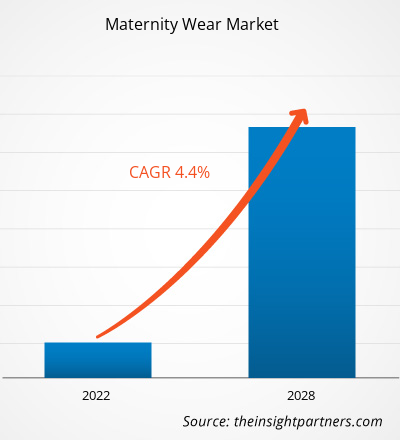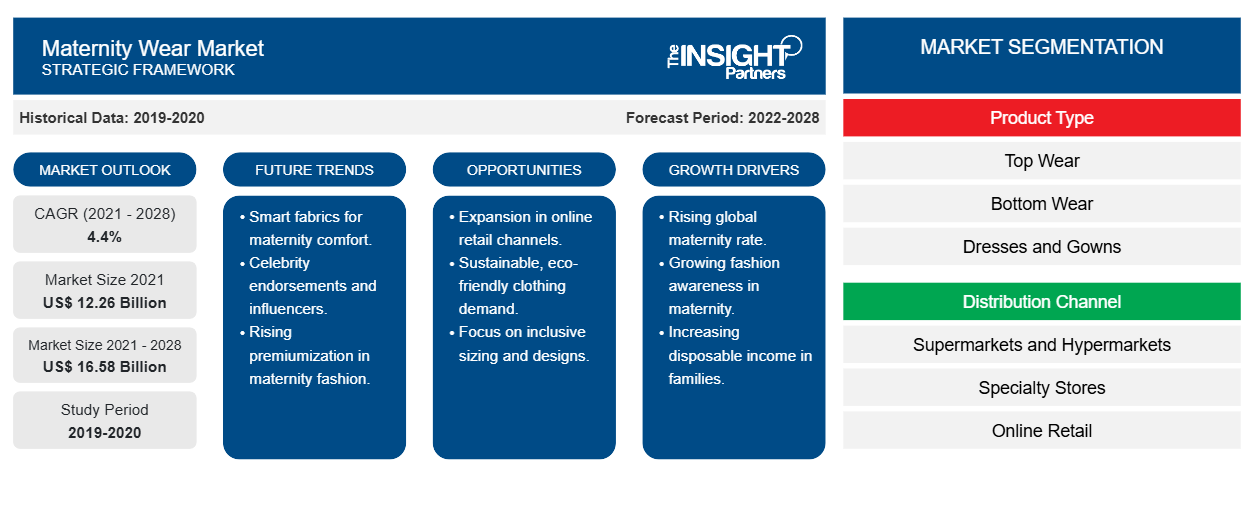El mercado de ropa de maternidad se valoró en US$ 12.257,41 millones en 2021 y se proyecta que alcance los US$ 16.578,64 millones en 2028; se espera que crezca a una CAGR del 4,4% de 2021 a 2028.
La ropa de maternidad generalmente se crea con un ajuste holgado y apropiado que contiene elástico, lengüetas y tela elástica, como elastano y spandex, para brindar mayor comodidad a la consumidora durante el embarazo.
En 2020 , la región de Asia y el Pacífico tuvo la mayor participación en el mercado mundial de ropa de maternidad , mientras que se espera que América del Norte registre la CAGR más alta durante el período de pronóstico. Según el informe del Banco Mundial, en los EE. UU. hay un promedio del 85 % de mujeres embarazadas que trabajan. Por lo tanto, está aumentando la demanda de ropa de maternidad y tallas grandes en ropa formal en la sección de vestidos y batas formales. Este es un factor importante que contribuye al crecimiento del mercado de ropa de maternidad en América del Norte.
Impacto de la pandemia de COVID-19 en el mercado de ropa de maternidad
La pandemia de COVID-19 ha afectado negativamente a muchas industrias, incluida la industria de bienes de consumo. La pandemia creó dificultades operativas debido a los confinamientos, el cierre de empresas y las interrupciones de la cadena de suministro. Las tiendas minoristas de ropa y prendas de vestir registraron grandes pérdidas en ventas. Los resultados financieros publicados por marcas de moda como el grupo español Inditex y la sueca H & M pusieron de manifiesto la enormidad del impacto de la pandemia. Además, el comercio electrónico experimentó un beneficio duradero de la pandemia, ya que la mayoría de los compradores en línea consideran el comercio electrónico como una opción pospandémica. Además, se proyecta que el aumento de las tasas de vacunación, la reactivación de las actividades de fabricación y la relajación de las regulaciones gubernamentales influyan positivamente en el mercado mundial de ropa de maternidad durante el período de pronóstico.
Personalice este informe según sus necesidades
Obtendrá personalización en cualquier informe, sin cargo, incluidas partes de este informe o análisis a nivel de país, paquete de datos de Excel, así como también grandes ofertas y descuentos para empresas emergentes y universidades.
-
Obtenga las principales tendencias clave del mercado de este informe.Esta muestra GRATUITA incluirá análisis de datos, desde tendencias del mercado hasta estimaciones y pronósticos.
Perspectivas del mercado
La adopción de estrategias de crecimiento empresarial impulsa el crecimiento del mercado
Los actores bien establecidos en el mercado adoptan varias estrategias para superar los desafíos actuales y futuros para la expansión de la empresa. Por ejemplo, Isabella Oliver adoptó una estrategia de penetración en el mercado al lanzar un programa de alquiler de ropa de maternidad para mejorar su alcance. El 20 de enero de 2020, la marca lanzó nuevamente un nuevo programa de alquiler para volverse circular y aumentar la longevidad de la ropa de maternidad. Isabella Oliver ofreció a sus clientes la nueva gama de opciones para alquilar un vestido, incluida la ropa de fiesta y los elementos básicos del embarazo, durante dos semanas, antes de devolverlo sin cargo. La marca incluso se encarga de la limpieza en seco. Los clientes también pueden comprar el producto. La idea de alquilar ropa de maternidad es alentar a los clientes a ser más ecológicos y eliminar los efectos de la moda rápida. Entonces, las innovaciones y las penetraciones de productos llevaron a un aumento en la demanda de ropa de maternidad. Estos factores están impulsando el crecimiento del mercado de ropa de maternidad.
Información sobre el canal de distribución
Según el canal de distribución, el mercado de ropa de maternidad se segmenta en supermercados e hipermercados, tiendas especializadas, venta minorista en línea y otros. Se espera que el segmento minorista en línea registre la CAGR más alta durante el período de pronóstico. El comercio electrónico jugó un papel vital durante los meses iniciales de la pandemia de COVID-19, ya que no se permitió que las tiendas minoristas físicas operaran. Durante los confinamientos, las personas utilizaron cada vez más plataformas de comercio electrónico para comprar productos esenciales y no esenciales. La crisis económica debido al brote de COVID-19 resultó en una reducción de los ingresos disponibles de las mujeres. Sin embargo, la demanda de ropa de maternidad no se vio afectada. Como resultado, es probable que los precios competitivos se conviertan en una característica clave del panorama completo en el futuro. Se proyecta que este factor potencialmente impulsará el crecimiento del mercado para el segmento minorista en línea durante el período de pronóstico.
Información sobre el tipo de producto
Según el tipo de producto, el mercado de ropa de maternidad se segmenta en ropa superior, ropa inferior, vestidos y batas, y ropa interior . El segmento de ropa superior representó una mayor participación de mercado en 2020, y se espera que el segmento de vestidos y batas registre una CAGR más alta durante el período de pronóstico. La ropa superior de maternidad consta de ropa formal y ropa informal. Además, la demanda de ropa formal de maternidad está aumentando debido al creciente número de mujeres trabajadoras. La ropa superior formal de maternidad consta de kurtis, blusas, vestidos de tirantes de material suave, blazers y gabardinas con capas dobles. La ropa informal comprende túnicas, vestidos largos y sudaderas y camisetas de gran tamaño. La ropa de maternidad está hecha de telas de la mejor calidad con materiales naturales y cómodos, como algodón, modal y bambú , ya que son suaves y permiten una respiración constante. Las mujeres embarazadas tienden a elegir el material de acuerdo con los cambios estacionales. En verano, prefieren telas de lino que repelen el calor para facilitar la circulación del aire, mientras que en invierno, prefieren abrigos de lana cálidos para prevenir el frío.
Algunos actores que operan en el mercado de ropa de maternidad son Gap Inc, Seraphine, Isabella Oliver, H and M Hennes and Mauritz AB, Brunelli and Co SRL, Mothercare, Boob Design, SHAICO Fashion Pvt. Ltd, Pink Blush Maternity y Organic & More.
Perspectivas regionales del mercado de ropa de maternidad
Los analistas de Insight Partners explicaron en detalle las tendencias y los factores regionales que influyen en el mercado de ropa de maternidad durante el período de pronóstico. Esta sección también analiza los segmentos y la geografía del mercado de ropa de maternidad en América del Norte, Europa, Asia Pacífico, Oriente Medio y África, y América del Sur y Central.

- Obtenga datos regionales específicos para el mercado de ropa de maternidad
Alcance del informe de mercado de ropa de maternidad
| Atributo del informe | Detalles |
|---|---|
| Tamaño del mercado en 2021 | US$ 12,26 mil millones |
| Tamaño del mercado en 2028 | US$ 16,58 mil millones |
| CAGR global (2021-2028) | 4,4% |
| Datos históricos | 2019-2020 |
| Período de pronóstico | 2022-2028 |
| Segmentos cubiertos |
Por tipo de producto
|
| Regiones y países cubiertos |
América del norte
|
| Líderes del mercado y perfiles de empresas clave |
|
Densidad de actores del mercado: comprensión de su impacto en la dinámica empresarial
El mercado de ropa de maternidad está creciendo rápidamente, impulsado por la creciente demanda de los usuarios finales debido a factores como la evolución de las preferencias de los consumidores, los avances tecnológicos y una mayor conciencia de los beneficios del producto. A medida que aumenta la demanda, las empresas amplían sus ofertas, innovan para satisfacer las necesidades de los consumidores y aprovechan las tendencias emergentes, lo que impulsa aún más el crecimiento del mercado.
La densidad de actores del mercado se refiere a la distribución de las empresas o firmas que operan dentro de un mercado o industria en particular. Indica cuántos competidores (actores del mercado) están presentes en un espacio de mercado determinado en relación con su tamaño o valor total de mercado.
Las principales empresas que operan en el mercado de ropa de maternidad son:
- brecha inc
- Serafina
- Isabella Oliver
- H&M Hennes y Maurits
- Brunelli & Cía. SRL
Descargo de responsabilidad : Las empresas enumeradas anteriormente no están clasificadas en ningún orden particular.

- Obtenga una descripción general de los principales actores clave del mercado de ropa de maternidad
Informe Destacado
- Tendencias progresivas de la industria en el mercado de ropa de maternidad para ayudar a los actores a desarrollar estrategias efectivas a largo plazo
- Estrategias de crecimiento empresarial adoptadas por los mercados desarrollados y en desarrollo
- Análisis cuantitativo del mercado de ropa de maternidad de 2019 a 2028
- Estimación de la demanda mundial de ingredientes lácteos
- Análisis de las cinco fuerzas de Porter para ilustrar la eficacia de los compradores y proveedores que operan en la industria
- Avances recientes para comprender el escenario competitivo del mercado
- Tendencias y perspectivas del mercado, así como factores que impulsan y restringen el crecimiento del mercado de ropa de maternidad
- Asistencia en el proceso de toma de decisiones destacando las estrategias de mercado que sustentan el interés comercial y conducen al crecimiento del mercado.
- El tamaño del mercado de ropa de maternidad en varios nodos
- Descripción detallada y segmentación del mercado, así como la dinámica de la industria de ropa de maternidad.
- Tamaño del mercado de ropa de maternidad en varias regiones con oportunidades de crecimiento prometedoras
- Análisis histórico (2 años), año base, pronóstico (7 años) con CAGR
- Análisis PEST y FODA
- Tamaño del mercado, valor/volumen: global, regional y nacional
- Industria y panorama competitivo
- Conjunto de datos de Excel
Informes recientes
Informes relacionados
Testimonios
Razón para comprar
- Toma de decisiones informada
- Comprensión de la dinámica del mercado
- Análisis competitivo
- Información sobre clientes
- Pronósticos del mercado
- Mitigación de riesgos
- Planificación estratégica
- Justificación de la inversión
- Identificación de mercados emergentes
- Mejora de las estrategias de marketing
- Impulso de la eficiencia operativa
- Alineación con las tendencias regulatorias























 Obtenga una muestra gratuita para - Mercado de ropa de maternidad
Obtenga una muestra gratuita para - Mercado de ropa de maternidad